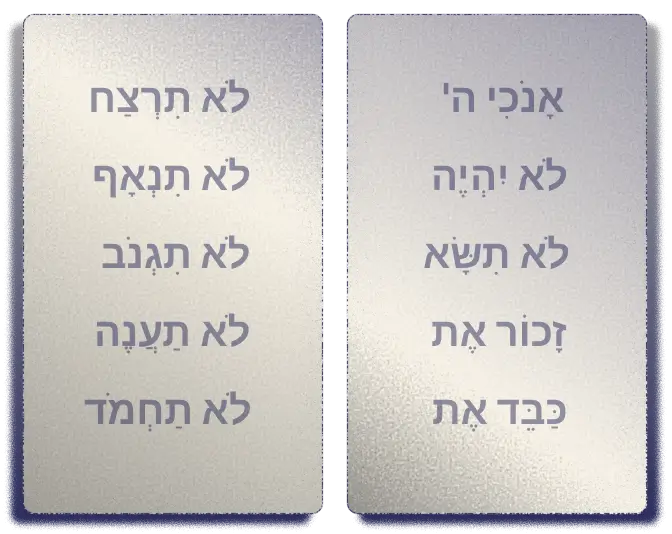

The clarity that precedes Ruach HaKodesh
“Know before Whom you stand.” — Berachot 28b
“Examine your deeds… weigh them on the scales of reason.” — Mesilat Yesharim 3:4
Part I traced Avraham’s awakening: the breaking of idols, the discovery of One G-d, and the first steps toward Ruach HaKodesh—prophetic clarity born from devotion. Yet, as the Ramchal explains, holiness does not descend unguarded; it is cultivated through a vigilant life. The first rung of the ladder toward Divine inspiration is Zehirut—watchfulness.
Ramchal (Mesilat Yesharim 2:1):
“The idea of watchfulness is for one to be cautious of his deeds and matters, namely, contemplating and watching over his deeds and ways whether they are good or evil; not abandoning his soul to the danger of destruction… and not walking through the course of habit like a blind man in darkness.”
(Mesilat Yesharim 2)
Avraham embodies this definition: each altar he builds, each journey he takes, is a conscious act—“Vayisa Avram halocha v’nasoa haNegev,” walking with deliberation (Genesis 12:9). His spiritual elevation begins not in ecstasy but in awareness.
Ramchal warns that nothing degrades the soul more than inattentive living:
Ramchal (Mesilat Yesharim 2:2–4):
“Reason certainly obligates this. For after a person has knowledge and reason to save himself… how is it conceivable that he would willingly blind his eyes from saving himself?! There is certainly no debasement and foolishness worse than this… One who walks along in his world without contemplating whether his ways are good or evil is similar to a blind man walking on the bank of a river.”
(Mesilat Yesharim 2)
This blindness is not ignorance—it is chosen distraction. Jeremiah cries, “No man repents of his evil, saying, ‘What have I done?’ Each runs to his course, like a horse charging into battle” (Jeremiah 8:6). Ramchal calls this “habitual motion”—life lived in reflex rather than reflection.
Avraham reverses this condition: he pauses to gaze at the heavens, argues with G-d over Sodom, and measures every act against Divine justice. Where others run, he stands.
The Ramchal exposes a cunning adversary: the yetzer hara enslaves through busyness. Like Pharaoh’s edict “Let the work be made heavier” (Exodus 5:9), evil keeps the heart preoccupied so it cannot think. Thus the prophet exhorts, “Set your heart upon your ways” (Haggai 1:5–7).
Zehirut begins with reclaiming time—moments of silence reclaimed from noise. In those pauses, Avraham hears the first Lech Lecha.
Ramchal builds on Pirkei Avot 2:1 (“Examine your deeds”) and Eruvin 13b, teaching two layers of introspection:
“The intelligent person must set aside fixed times each day, as great merchants do, to reckon their accounts.” (Mesilat Yesharim 3)
The terms originate in rabbinic self-audit imagery, later extended to Torah study in Eruvin 54b, where the learner repeatedly “fondles” the text to draw new insight. Ramchal applies this tactile metaphor to the soul itself: continual re-engagement that prevents spiritual stagnation.
To those trapped in the maze of worldly confusion, Ramchal compares life to a garden maze (gan ha-mevucha). Only from the tower (achsadra) can one see the right path and call out, “This is the way—walk in it!” (Mesilat Yesharim 3).
Avraham becomes that tower. Having reached clarity through watchfulness, he stands above the labyrinth and calls humanity toward moral vision: “For I have known him, that he may command his children… to keep the way of the L-rd.” (Genesis 18:19)
Talmud (Yevamot 121a): “The Holy One scrutinizes His pious ones to the degree of a hair’s breadth.” (Yevamot 121a)
Avraham’s own trials exemplify this scrutiny:
The nearer one draws to G-d, the finer the calibration. Avraham’s life teaches that intimacy and accountability are the same condition.
“Torah brings to Watchfulness” (Mesilat Yesharim 4:1). Through Torah, conscience becomes illuminated. Ramchal distinguishes three audiences:
Avraham belongs to the first: his study and faith merge, forming the consciousness that will later flower into Ruach HaKodesh—clear sight in Divine presence.
Ramchal concludes: strict justice would annihilate imperfection; mercy introduces time—space for repentance. “The uprooting of the will is counted as the uprooting of the deed” (Kiddushin 40a — the Talmudic origin of “machashava tovah mitztarefet l’maaseh” (“the thought of repentance is joined to the deed”); Mesilat Yesharim 4 — Ramchal’s formulation of “uprooting of will = uprooting of deed.”)
Thus Zehirut is the threshold of redemption: awareness opens the door to change. Avraham’s path of mercy — praying even for Sodom — embodies this balance between din and rachamim. — for “G-d shall bring every deed into judgment” (Ecclesiastes 12:14), yet His ways are perfect in justice and mercy (Deuteronomy 32:4).
In Mesilat Yesharim, Zehirut precedes Zerizut (alacrity), then Nekiyut and Taharah (Cleanliness and Purity of Intention), until finally Ruach HaKodesh. Avraham’s biography traces the same ascent: reflection (Zehirut), prompt obedience (Zerizut), purified intention (Nekiyut and Taharah), and ultimately prophecy (Ruach HaKodesh).
His journey maps the inner structure of human perfection.
Primary
Secondary / Orientation








Lech Lecha
Avraham’s first mindful Lech lecha move; each altar is a deliberate act of awareness. His journey inaugurates the discipline of conscious motion — every step measured, every pause sanctified. Zehirut begins as walking with intention.
Vayera
Vigilance tested: hospitality under strain, Sedom’s judgment, and the Akeidah’s precision “to a hair’s breadth.” Avraham’s attentiveness to both kindness and command reveals how divine fear and love merge through exact action.
Chayei Sarah
Eliezer’s mission exemplifies watchful ethics — integrity in speech, restraint in self-interest, and prayer before decision. Zehirut here becomes faith expressed through meticulous honesty in human dealings.
Shemot
A new stage of vigilance unfolds: Israel’s awakening in exile. Moshe’s “turning aside to see” the burning bush models contemplative attention — the eyes that notice, the heart that responds. The nation’s formation under fire refines awareness from personal devotion to collective mission.
Yitro
“Know before Whom you stand.” Sinai itself is the revelation of Zehirut: boundaries established, preparation commanded, every soul trembling in mindful awe. Divine law becomes the architecture of vigilance.
Kedoshim
Speech, rebuke, love your fellow — relational vigilance made law. Zehirut matures into holiness, where precision in ethics equals sanctity in worship.
Shelach
Tzitzit as anti-distraction practice: “do not follow your heart and eyes.” The spies’ failure dramatizes the peril of unguarded perception; the fringes become daily reminders to look through faith, not appetite.
Eikev
“Remember” and “do not forget” — the rhythm of gratitude and humility. True watchfulness is retrospective: awareness of blessing, vigilance in prosperity.
Shoftim
Judges, bribes, majority — the ethical scales of accountability. National Zehirut emerges as civic precision: justice without bias, reason weighing impulse. The personal tower becomes societal.


#1 · To know there is a G-d — Exodus 20:2
In Lech Lecha: Avram responds to direct revelation (“HaShem said to Avram: Lech lecha”), lives by that knowledge, and builds altars in gratitude.
In Shemot: Israel learns that knowledge is not abstract; “I am HaShem your G-d” transforms faith into a national consciousness that demands constant awareness.
Narrative roots: Genesis 12:1-7, 12:8, 13:4.
#2 · Not to entertain thoughts of other gods — Exodus 20:3
In Lech Lecha: Avram rejects the mental idols of Mesopotamia—his first act of Zehirut is inward: clearing the heart’s distractions before stepping forward.
In Shemot: Egypt’s collapse of false divinities dramatizes vigilance of thought; redemption begins by purging mental idolatry.
Narrative roots: Genesis 11:31–12:1, 15:7.
#3 · To know that He is One — Deuteronomy 6:4
In Lech Lecha: Avram proclaims unity amidst plurality; he embodies mindful coherence against the noise of nations.
In Shemot: “I am that I am” (Exodus 3:14) becomes the watchword of clarity—awareness stripped of illusion.
Narrative roots: Genesis 12:8, 13:4.
#4 · To love Him — Deuteronomy 6:5
In Lech Lecha: Avram leaves all for love; he “calls out” in HaShem’s Name, turning personal affection into mission.
In Shemot: Love matures through service—Israel follows HaShem into the desert, sustained by trust.
Narrative roots: Genesis 12:1-4, 18:18-19.
#5 · To fear Him — Deuteronomy 10:20
In Lech Lecha: Avram’s awe is revealed in covenantal obedience; his yirah keeps passion balanced by humility.
In Shemot: Sinai’s thunder engraves this awe—“so that His fear may be before you, that you not sin.”
Narrative roots: Genesis 15:12, 22:12.
#6 · To sanctify His Name — Leviticus 22:32
In Lech Lecha: Avram’s refusal of Sodom’s spoils creates the first public Kiddush Hashem; he chooses moral clarity over gain.
In Shemot: Moshe’s leadership magnifies that sanctity—acting so the nations will say, “Surely this is a wise and understanding people.”
Narrative roots: Genesis 14:21-23.
#7 · Not to profane His Name — Leviticus 22:32
In Lech Lecha: Avram’s care in conduct, speech, and alliances models micro-accountability—the essence of Zehirut.
In Shemot: The contrast to Pharaoh’s arrogance underscores how desecration begins in neglect of moral vigilance.
Narrative roots: Genesis 14:18-24.
#9 · Listen to the prophet — Deuteronomy 18:15
In Lech Lecha: Avram becomes prototype prophet by listening first; Divine instruction births movement.
In Shemot: Israel’s challenge is the same—heeding Moshe amid confusion distinguishes faith from impulse.
Narrative roots: Genesis 12:1, 15:1.
#10 · Not to test the prophet unduly — Deuteronomy 6:16
In Lech Lecha: Avram asks with humility, not cynicism; his questions refine rather than rebel.
In Shemot: “Do not test HaShem” is learned through the desert’s scarcity—a discipline of trustful restraint.
Narrative roots: Genesis 15:8-18.
#11 · To emulate His ways — Deuteronomy 28:9
In Lech Lecha: Avram rescues captives, gives freely, and acts with mercy—early mirror of rachum ve-chanun.
In Shemot: HaShem “passes before Moshe” revealing the Thirteen Attributes; Zehirut now means embodying mercy consciously.
Narrative roots: Genesis 14:14-24.
#12 · Cleave to those who know Him — Deuteronomy 10:20
In Lech Lecha: Avram gathers souls in Haran—a proto-community of Daʿat Hashem rooted in mindful fellowship.
In Shemot: Yitro’s arrival models the same: wisdom joins vigilance; community sustains awareness.
Narrative roots: Genesis 12:5, 18:19.
#13 · Love other Jews — Leviticus 19:18
In Lech Lecha: Avram intercedes for Sodom; compassion even for the undeserving is moral watchfulness.
In Shemot: Moshe’s empathy—“he saw their burdens”—turns perception into action.
Narrative roots: Genesis 18:23-33.
#15 · Not to hate — Leviticus 19:17
In Lech Lecha: Avram parts from Lot peacefully; vigilance of heart avoids resentment.
In Shemot: The command “do not hate your brother in your heart” is embodied by Moshe reconciling Israel.
Narrative roots: Genesis 13:8-9.
#16 · Reprove wrongdoers — Leviticus 19:17
In Lech Lecha: Avram challenges corruption yet with dignity; correction begins with self-scrutiny.
In Shemot: Moshe’s rebuke of Israel is tempered by love—a model of mindful confrontation.
Narrative roots: Genesis 14:21-24.
#17 · Not to embarrass others — Leviticus 19:17
In Lech Lecha: Avram negotiates honorably with kings; never shames in persuasion.
In Shemot: Moshe veils his face—respect for spiritual boundaries as emotional Zehirut.
Narrative roots: Genesis 14:21-24.
#19 · Not to gossip — Leviticus 19:16
In Lech Lecha: Avram guards his speech before Pharaoh; silence becomes wisdom.
In Shemot: Miriam’s episode later crystallizes this vigilance of tongue.
Narrative roots: Genesis 12:10-20.
#20 · Not to take revenge — Leviticus 19:18
In Lech Lecha: Avram rescues Lot despite betrayal; self-control triumphs over grievance.
In Shemot: The mitzvah “do not take revenge” matures from his model—redemption through restraint.
Narrative roots: Genesis 14:14-16.
#21 · Not to bear a grudge — Leviticus 19:18
In Lech Lecha: Avram’s forgiveness of Lot sets emotional boundaries free of bitterness.
In Shemot: National healing demands memory without resentment—core of covenantal maturity.
Narrative roots: Genesis 13:8-11.
#22 · Learn and teach Torah — Deuteronomy 6:7
In Lech Lecha: Avram “calls out” in HaShem’s Name—spreading awareness through teaching.
In Shemot: Moshe receives Torah to transmit vigilance into law—Torah as the tower itself.
Narrative roots: Genesis 12:8, 18:19.
#23 · Honor Torah scholars — Leviticus 19:32
In Lech Lecha: Avram’s hospitality to angels models reverence for wisdom.
In Shemot: Elders at Sinai reflect disciplined hierarchy—honoring vessels of daʿat.
Narrative roots: Genesis 18:1-8.
#25 · Not to follow heart or eyes — Numbers 15:39
In Lech Lecha (contrast): Lot “lifts his eyes” toward Sodom; Avram chooses faith over optics—Zehirut in vision.
In Shemot: The golden calf episode replays this warning; spiritual vigilance rejects sight without insight.
Narrative roots: Genesis 13:10-12, 15:5-6.
#75 · Repent and confess — Numbers 5:7
In Lech Lecha: Avram’s altars are confessions of gratitude and renewal—pishpush in stone.
In Shemot: National teshuvah begins with acknowledgment—“We have sinned.”
Narrative roots: Genesis 12:8, 13:4.
#76 · Say Shema twice daily — Deuteronomy 6:7
In Lech Lecha: Avram’s constant proclamation mirrors daily re-anchoring of awareness.
In Shemot: “HaShem Echad” realized through the Exodus rhythm—day and night mindfulness.
Narrative roots: Genesis 12:8.
#77 · Serve with prayer daily — Exodus 23:25
In Lech Lecha: Avram’s altars and invocations function as proto-tefillah—service of the heart before Sinai.
In Shemot: Moshe’s pleas for Israel transform emotion into structure; devotion through discipline.
Narrative roots: Genesis 12:8, 13:4.
#84 · Tzitzit — Numbers 15:38
In Lech Lecha: The call “Lift up your eyes toward Heaven” anticipates tzitzit’s reminder to see through faith.
In Shemot: Garment mitzvot mature into embodied mindfulness—Zehirut woven into daily dress.
Narrative roots: Genesis 15:5-6.
#85 · Bless HaShem after eating — Deuteronomy 8:10
In Lech Lecha: Melchizedek blesses “Kel Elyon” for Avram’s deliverance; gratitude seals vigilance.
In Shemot: Manna teaches awareness through satiation—mindfulness after fulfillment.
Narrative roots: Genesis 14:18-24.
#91 · Sanctify Shabbat with Kiddush and Havdalah — Exodus 20:8
In Lech Lecha: Avram’s pauses between journeys mark holy transitions—proto-Shabbat consciousness.
In Shemot: Creation–Exodus rhythm codified; Zehirut in sacred timing.
Narrative roots: Genesis 13:3-4.
#469 · Ensure accurate weights — Leviticus 19:36
In Lech Lecha: Avram’s dealings are scrupulous; fairness in measure as moral calibration.
In Shemot: The Mishkan’s sockets of silver—“a beka a head”—teach precision as holiness.
Narrative roots: Genesis 14:22-24.
#470 · No injustice with weights — Leviticus 19:35
In Lech Lecha: Ethical balance mirrors Ramchal’s metaphorical scales of reason.
In Shemot: Justice tempered by mercy at Sinai forms national conscience.
Narrative roots: Genesis 18:19.
#489 · Do not stand idly by — Leviticus 19:16
In Lech Lecha: Avram rushes to rescue Lot; spiritual alacrity defines true watchfulness.
In Shemot: Moshe “looks this way and that” before defending a brother—vigilant courage in action.
Narrative roots: Genesis 14:14-16.
#493 · Remove hazards — Deuteronomy 22:8
In Lech Lecha: Avram’s foresight prevents harm to those around him—he builds ethical guardrails.
In Shemot: Camp laws of safety literalize this principle—Zehirut becomes communal.
Narrative roots: Genesis 13:8-9.
#494 · Make a guard rail — Deuteronomy 22:8
In Lech Lecha: Avram establishes boundaries of peace with Lot; preventive vigilance.
In Shemot: Sinai’s boundaries (“do not approach the mountain”) echo physical and spiritual fences.
Narrative roots: Genesis 13:8-12.
#563 · Judge righteously — Leviticus 19:15
In Lech Lecha: Avram’s arbitration with Lot anticipates “weighing actions on the scales of reason.”
In Shemot: Yitro’s judicial system institutionalizes mindful discernment.
Narrative roots: Genesis 13:8-11, 18:19.
#578 · Follow Sanhedrin’s ruling — Deuteronomy 17:11
In Lech Lecha: Avram’s obedience to Divine guidance models acceptance of higher law.
In Shemot: Moshe and the seventy elders embody the living tower of direction.
Narrative roots: Genesis 12:1-4.
#579 · Do not deviate from Sanhedrin — Deuteronomy 17:11
In Lech Lecha: Self-discipline restrains Avram’s independence; submission to daʿat Elokim ensures balance.
In Shemot: “According to the Torah they shall instruct you”—Zehirut through deference.
Narrative roots: Genesis 12:4, 17:23.
#580 · Do not add to mitzvot — Deuteronomy 13:1
In Lech Lecha: Avram’s faith is exact, not inflated—he fulfills command precisely, not excessively.
In Shemot: Precision of Mishkan worship guards against distortion; zeal bounded by wisdom.
Narrative roots: Genesis 22:2-12.
#581 · Do not diminish mitzvot — Deuteronomy 13:1
In Lech Lecha: Avram leaves nothing half-done; totality is his vigilance.
In Shemot: “See that you do all that I show you”—fidelity to detail completes Zehirut.
Narrative roots: Genesis 17:23-27.

Dive into mitzvot, prayer, and Torah study—each section curated to help you learn, reflect, and live with intention. New insights are added regularly, creating an evolving space for spiritual growth.

Explore the 613 mitzvot and uncover the meaning behind each one. Discover practical ways to integrate them into your daily life with insights, sources, and guided reflection.

Learn the structure, depth, and spiritual intent behind Jewish prayer. Dive into morning blessings, Shema, Amidah, and more—with tools to enrich your daily connection.

Each week’s parsha offers timeless wisdom and modern relevance. Explore summaries, key themes, and mitzvah connections to deepen your understanding of the Torah cycle.